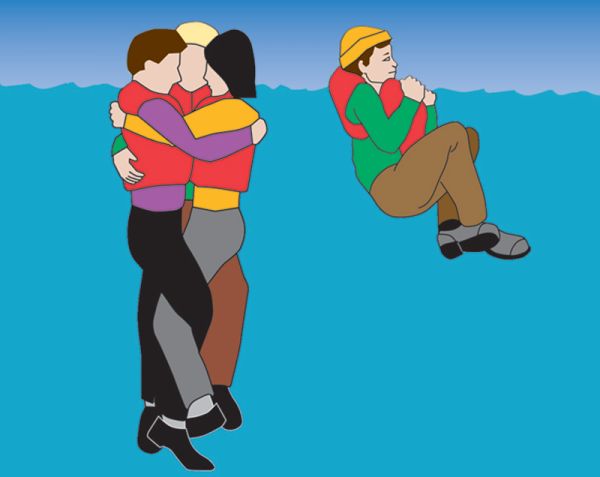Cold water and hypothermia
Cold water can be dangerous, even in summer. Here's what to do to prevent hypothermia and cold shock if you fall in the water, plus how to treat hypothermia.
Dangers of cold water
Water can be dangerously cold, even on sunny days. Water temperatures below 15°C are dangerous. These low temperatures can happen in alpine waters all year round, and on most NSW waterways in winter and parts of spring and autumn.
Water can be dangerously cold on sunny days.
Your risk of hypothermia is higher when you're exposed to the elements. Falling into cold water can be life-threatening.
Hypothermia
Hypothermia is the result of heat loss from the body’s core. It happens when your body temperature drops below 35°C. This affects your brain, heart and other internal organs.
As soon as you enter the water, your body begins to cool, but the full effects of hypothermia can take around 30 minutes to develop.
Some of the signs of hypothermia are:
- intense shivering in the early stages as the body tries to maintain its core temperature
- slurred speech and confusion
- slowing pulse as blood flow to the hands, feet and skin slows down
- dilated pupils
- no shivering in the later stages.
Eventually a hypothermic person will lose consciousness.
Hypothermia can be mistaken for drowsiness. Look out for these signs and symptoms:
- adults – cold to touch, pulse slow, weak or faint, breathing slow and shallow
- children – cold to touch, quiet, lacking appetite.
Cold shock
Cold shock is an uncontrollable reaction in your body when it enters cold water suddenly. Your breathing and heart rate speed up sharply. You can inhale water while trying to catch your breath.
Cold shock goes away quickly, but can be dangerous in the first few moments.

Cold water can be dangerous
What to do
In the water
If you fall overboard, try to stay calm. Resist the temptation to swim – this increases body heat loss. Stay with the vessel.
If you're stuck in cold water, these techniques can help extend survival time.
If you can, try to get back onto your vessel as quickly as possible or get as much of your body out of the water as possible. Only swim for shore if it is very close and you are sure you can make it quickly.
HELP (Heat Escape Lessening Posture)
If you're alone, the best option to limit body heat loss is the HELP position. Draw your knees to your chest and wrap your arms around your knees. Clasp your hands together so you're in a tucked position. Stay in this position.
Huddle
If you're in the water with others, huddling is the best method of reducing the risk of hypothermia. Huddle close together to protect your chests and arms. This can reduce the rate at which your bodies lose heat and can increase survival time by up to 50%.

How to treat hypothermia
When treating hypothermia, the aim is to reduce any further heat loss and to try to warm up the person slowly. You must act quickly, but gently.
If you suspect someone has hypothermia:
- Replace all wet clothing with warm, dry clothing or blankets, if available.
- Be gentle and keep them still.
- Let them warm up slowly – never put them close to a heater or in a hot bath. Use:
- an aluminium space blanket
- warm towels and blankets
- a wrapped hot water bottle, and/or
- body heat.
- Give them warm drinks, but never alcohol – it increases the body's heat loss.
- Give them CPR, if necessary, and call for help as soon as possible.
Reduce the risk
- Wear a lifejacket over clothing or wet weather gear. If you fall into the water, a lifejacket will help you manage cold shock, conserve your energy and prevent you from inhaling water. It will also give you more time to get back into your vessel or for someone to help you.
- Be prepared before you go on the water, especially in winter and on alpine waters.
- Know the water temperature and check weather conditions.
- Wear warm clothing under your wet weather gear.
- Open runabouts (small, open boats designed for day cruising and watersports) and paddle craft (canoes, kayaks and dragon boat type craft) are some of the most popular vessels on our waterways. However, on these vessels, people are more likely to end up in the water through capsizing, swamping, or falling overboard.